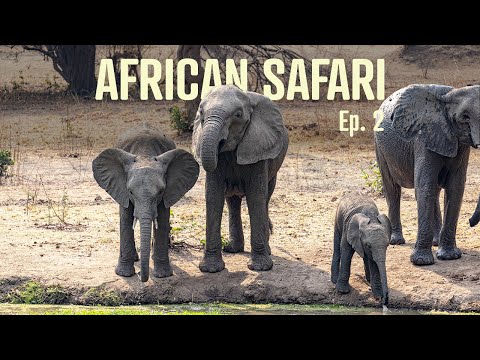African Safari in Zambia, Ep. 2: Bilimungwe Wildlife

From elephants coming into camp to some of the most beautiful birds you'll ever see, settle into the laid back pace of life at the bush camps. Go on your first walking safari to get closer to South Luangwa’s wildlife than you've ever been. See lions feast on a recent kill and get your feet wet for the ultimate bush dining experience. Born in South Luangwa National Park, the Walking Safari is the ultimate way to connect with the park's plant and wildlife.
The rules are simple. Walk in a straight line, keep noise to a minimum, and follow the guy with a gun. You'll be rewarded with an incredibly intimate experience soaking in the guides’ wealth of knowledge. So who would have come up or down? Sorry. Who would have come up or down? Elephants. Elephants? Really? Okay. Yeah.
Elephants will Surprise you how steep the banks So they can climb up this Termites taking over or what? Places like Choma. You go to Choma between Monze and Choma there There is just huge dome-shaped I mean, the whole landscape is just termites. You can literally, I think tourists, there can be an attraction in itself. Really incredible. Yeah. But the macrotermes is the most common species of termite here, which is who’s mound we’re looking at and it’s a huge mushroom termite mound. This mount is not as active.
You can see all the holes in an inactive state because you can see where the rains eroded and they have been patched up, the holes. But it will still be working inside? Yes. Yeah.
Well, when is it when the mound is in an active state, it's very, very difficult to tell where they’ve stayed or not. But most likely I Think it's very much a matter This tree in particular is called the Crystal Bark and it is hallucinogenic. There are two trees in Africa that are known to be hallucinogenic, and both of the species have the same use. West Africa it’s called the Bulgar,
which is hallucinogenic and here it's called the Crystal Bark. Crossopteryx febrifuga but mostly used to give to people that are practicing accused of practicing witchcraft. And it confuses them to the extent where they then confess that they're actually witches. At least that’s the trick. They get the roots or the bark,
soak it in water, make an infusion, then they force you to drink it. It’s still practiced today. I think the elephant was trying to debark the tree, you can see the tusking. But it looks really like claw marks, but they are way too big. We look over here. Oh yeah.
Typically leopard, lion claw marks would appear like that, but not as big as this. This definitely would have been an elephant trying to remove the bark from the tree. If the insects come out, if I disturb the entrance and the insects come out, then the aardvark is in there. Nothing is coming out. Perhaps not. So it is probably not in there because mostly the insects sit on the back of the aardvark and as it goes in they remain by the entrance.
And when you sort of disturb the entrance you see that this flies. Oh who knows, they could, it could even be in there. On our safari, we were fortunate enough to cross paths with Mike and Lisa, two professional ornithologists from Boston University. Along with our guide Manda, they gave us a fascinating look into the beautiful South Luangwa bird life we would not have seen otherwise. So the Marshall would have had a white, whiter breast? Oh, absolutely.
Back at camp after the morning game drive, we had a few visitors while we waited for brunch. Her ear? Oh, yeah. See the cartilage is broken? Yeah. Oh, no. So she's been like that for about 16 years.
She’s okay, she has a baby, too. Don't know, flight Or, so she can’t bend her ears? No, she can't bend that ear, which from a cooling point of view is bad because all her veins are exposed on the back of the ear. So half her air conditioning system is down, but she carries on. To float a log there for them because we have them in the past.
And they used to sit on Harry's back because Harry was a lot more accommodating. But this is what they're trying to get at. Hello. How's it going? There’s a little family of elephants including one that’s pretty small. It's just coming up to drink See how the left tusk is much more worn than the right? So he’s left-handed. These are our guides.
Is that for us? Oh my. Oh how fabulous. You’re welcome. Sausage? Sausage. And the trading. Yeah. Some refills? You like some refill? And I started going down the list until I got a reaction and it was about number five.
I got this dogged reaction. That’s a funny way to name a dog. Well so the people do that. Lots of buffalo droppings around. Must have been a big herd of buffalo not long ago around here. Moving towards the. Yeah I see it it's pretty down low, behind the grass.
And the other one is by the hill. There's the eye shine. very briefly. Oh, honey badger. Oh, look at him. Yeah. Look at him.
He's on a bank right there in the light. So they don't go in the water then very much. yeah, kind of, in the shallow end to catch fish.
Didn't perform They come out in the summer. I wonder what he’s digging for. Fascinating. There he is, running. We're heading off from Bilimungwe to look for cats and predators.
On our way to search for big cats, it's time for a lesson on South Luangwa’s diverse plant life. First up is the famed sausage tree. Real name and the scientific name is called Kigelia africana. Well, yes. You know, I call it the Tree of Life because of its properties to both humans and animals. Okay.
Why is the Tree of Life? Because 90% of animals benefit from this tree. We talk of zebras, we talk of hippos, elephants, giraffes, pukus, kudus, impalas, zebras, porcupines, squirrels, monkeys, baboons, even bats as well. And for the local people, we use it for the medicine. Okay. Medicine? Yes, the tree works a lot.
So, for example, our giraffes they go for the small one. When they’re green, they look like cucumber. Now, it's very hard to get and break it open. Then zebras, they go for both flowers and the fruit, once they fall on the ground.
You see this path, it’s from the hippo. So every night hippos go and check if there's one on the ground and then they feed on it. Like now, because you can see it’s quite bare There's no green grass for the animals to graze. So hippos follow the same fruit. Elephants, they eat both the flowers and the fruit.
Impalas. I've seen impalas before, under this tree, would wait for the flowers to fall, and then they pick from there Kudus, they also go for the flowers. And then baboons like primates, monkeys, baboons. They go for the fruit up there. If even squirrel, you know, squirrels, they go up there and eat from there.
Okay. Okay. It has pretty flowers. Yes. Pinkish. Yeah. I'll show you where on the ground. Yeah.
Also the, uh, what else? But from, uh, apart from people's admission about, um, also kudus, they go for the flowers. They pick there. Okay, so for the medicine um, we use, it's used many the, uh, the fruit you go for the fruit for example in a bite from the tsetse fly, you get the piece, you chop it, you rub on the spot that itch will go out. And also for anemia. Really, it works a lot.
If you go to Zimbabwe right now, there's a cream called kigelia cream that cures skin cancer from the same tree. The add chemicals to make that cream, it’s called kigelia cream And then for good East Africa they ferment beer they add with honey. Stuff. They make beer out of the sausage tree. But also here in Zambia, we make snuff, you know, snuff. Sell it as sausage, beer. Yes. Right. We make snuff.
We burn it ashes. Then you add tobacco, then make snuff. Oh, my goodness. Oh. So it works a lot.
It works a lot for both animals and animals. So I call it the Tree of Life. So if you can see this arrangement of trees, you know some are tall, some are short. And these trees are called mopani trees Mopani, yeah. No leaves, though.
This time of the year they lose or they shed some leaves. Um, to reduce the rate of transpiration. So a few months to come they’ll have some new leaves like middle of November, December, it’ll be green everywhere.
So these short ones we call them scrub Mopani and the tall ones we call them the Cathedral Mopani. Why are they short? It’s because of elephant destruction. Elephants love them a lot because the leaves of these trees, they contains a protein, they’re rich in protein, in short. So elephants come and browse them every day. And no wonder they look so short.
So these were so rare from the elephant destruction. Sometimes they go for the bark and also the leaves, but now they have no leaves. until the middle of next month to December.
One of the most incredible scenes on our whole safari was the Carmine Bee Eaters. In addition to being such colorful, beautiful tropical birds, just listen to the wonderful sound of their calls. Their color is so electric.
We just got word on the radio that there are some lions that made a kill so that's where we're heading now. Yeah, yeah. It was a young elephant. So that one is guarding the meal because once he moves from there oh, the vultures will all swoop in. Yeah. Within minutes, it’s gone So it’s guarding those. With that many vultures You would You would think so.
And these two over here sleeping off the food coma. Mmm hmm. They’ll change. That one will come here and this one will go there. Yeah. To keep an eye. That's so cool.
Well that was really cool. That was really serious. That was really cool. The lions were interesting. I mean, yeah, the face Hopefully we can get a glimpse of that leopard, too. Yeah that would be wonderful.
Yeah. As our morning game drive comes to a close, our bush camp hosts continue to outdo themselves So new birds? Yes? Wow. I keep thinking we’re going to have a walk or a drive without a new bird. Mmm hmm.
Which new birds? As we move into the afternoon game drive, soak in the magic as we continue our search for the fourth of Africa's big five. The leopard. Hello, hello.
Up next, move across the river to the Kapamba Bushcamp for more walking safaris as the wildlife seems to be getting better by the day. Then in your final game drive, put the cherry on top of your South Luangwa adventure, an incredibly rare sighting before we transfer over to Kasanka National Park for the famous bat migration. There's a leopard in the tree right behind us.
2023-05-20 05:01


